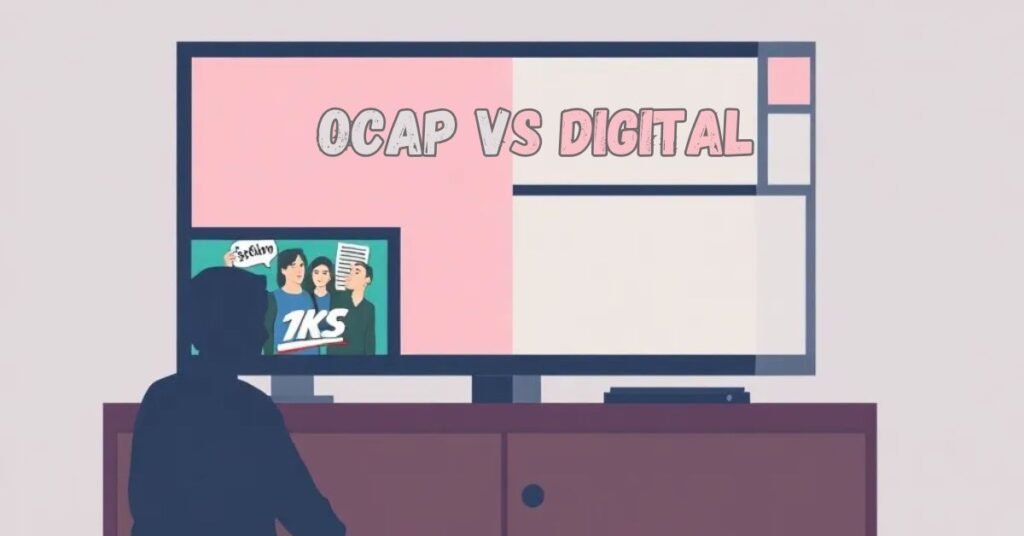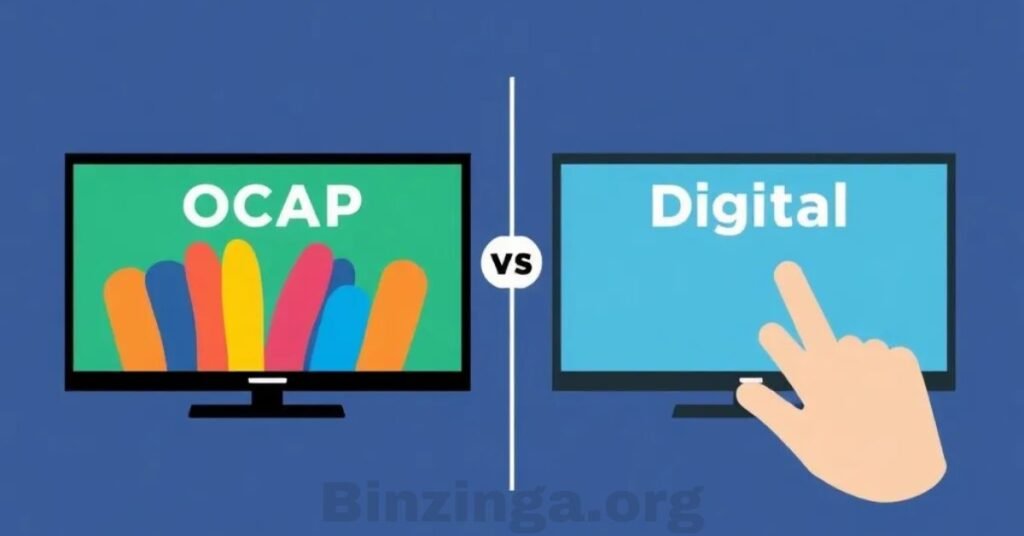In the debate of OCAP vs digital, it’s crucial to understand how these technologies shape our media consumption today. OCAP, or Open Cable Application Platform, offers a unique way to engage with cable television, while digital technologies revolutionize our interaction with content across various devices. As we dive deeper into this comparison, we’ll uncover the strengths and weaknesses of each, helping you make informed choices for your needs.
In this rapidly evolving landscape, knowing the differences between OCAP vs digital technologies can empower you as a consumer and creator. Whether you’re developing interactive applications or simply exploring your viewing options, understanding these platforms will guide you in making the best decisions for your entertainment and engagement.
Understanding OCAP: The Backbone of Interactive TV
OCAP vs digital, or OpenCable Application Platform, is a significant technology that makes cable television more interactive and engaging for viewers. Developed as part of the CableLabs initiative, OCAP provides a framework for creating interactive applications on cable TV. This means that instead of just watching shows, viewers can play games, shop online, and access on-demand videos right from their televisions. By incorporating OCAP, cable providers can offer unique experiences that transform how people enjoy their favorite content.
One of the key features of OCAP vs digital is its compatibility with set-top boxes. These boxes connect directly to cable services, allowing users to access a variety of interactive options easily. OCAP is built on the Java programming language, which makes it flexible and adaptable for developers. They can create new applications that work across different cable systems, ensuring that viewers have a consistent experience regardless of their service provider. This standardization is crucial in a market where users expect seamless access to interactive features.
Despite the rise of digital streaming services, OCAP vs digital continues to hold its ground. It plays an essential role in providing interactive capabilities specifically designed for cable TV. Many viewers appreciate the structured environment that OCAP offers, where they can engage with content in a more dynamic way. As the landscape of television continues to evolve, understanding the importance of OCAP helps consumers recognize its value in enhancing their overall viewing experience.
Digital Technologies: A New Era of Media Engagement
Digital technologies have revolutionized the way we consume and interact with media. Unlike OCAP vs digital, which focuses primarily on cable TV, digital platforms are accessible through the internet and a wide range of devices, including smartphones, tablets, and smart TVs. This broad accessibility means that viewers can watch their favorite movies and shows anytime, anywhere, without being tied to a cable service.
Streaming services such as Netflix, Hulu, and YouTube exemplify the capabilities of digital technologies. These platforms allow users to stream content directly on their devices, providing an extensive library of entertainment options. Viewers can enjoy not only movies and TV shows but also live events, educational content, and user-generated videos. This variety caters to diverse interests and preferences, making it easier for everyone to find something they enjoy.
Digital technologies enhance viewer engagement through interactive features. Users can comment on videos, share content on social media, and participate in live chats while watching shows. This level of interaction fosters a sense of community among viewers, allowing them to connect with others who share similar interests. As more people turn to digital options, the demand for engaging and interactive content continues to grow, further solidifying the importance of digital technologies in our daily lives.
OCAP vs Digital: Key Differences Explained
When comparing OCAP vs digital technologies, several key differences become apparent. First and foremost, OCAP is specifically designed for cable television, operating within a controlled environment. This means that OCAP applications are built to work seamlessly with set-top boxes and cable services. On the other hand, digital technologies operate across a vast range of platforms, including the internet, mobile devices, and smart TVs, providing much broader access to content.
Another important difference lies in user interactivity. OCAP vs digital does offer interactive features, but its capabilities are largely limited to cable subscribers. For example, viewers can engage with specific applications while watching content, but they cannot easily interact with a wider audience. In contrast, digital technologies allow for real-time engagement across multiple platforms. Users can comment, share, and participate in discussions, creating a more dynamic and interactive experience that goes beyond passive viewing.

Accessibility is also a critical factor in this comparison. OCAP vs digital is available only to those with cable TV subscriptions, which limits its reach. In contrast, digital platforms can be accessed globally by anyone with an internet connection. This accessibility not only broadens the audience for digital content but also encourages more diverse participation in the media landscape. Understanding these differences is essential for consumers and developers alike, as they navigate the evolving world of media engagement.
Interactivity: How OCAP and Digital Technologies Compare
Interactivity is a crucial aspect of both OCAP vs digital technologies, influencing how viewers engage with content. OCAP allows cable viewers to participate in various activities, such as playing interactive games and accessing video-on-demand services. This structured interactivity creates an immersive experience within the confines of cable television. Viewers can enjoy a more engaging way to watch TV, making it a valuable feature for cable providers aiming to retain their audience.
Digital technologies offer a broader range of interactive features that surpass the capabilities of OCAP vs digital. For example, platforms like YouTube enable viewers to leave comments, participate in live chats, and share their thoughts with a global audience. This real-time engagement enhances the viewing experience, allowing users to connect with others while enjoying content. It fosters a sense of community and collaboration, which is less prominent in the OCAP framework.
Ultimately, while both OCAP vs digital technologies aim to provide interactive experiences, digital platforms offer more diverse and engaging options. The ability to interact in real-time across multiple devices allows viewers to have a richer connection with content and other viewers. As the demand for interactivity continues to grow, digital technologies are likely to lead the way, offering innovative solutions that enhance user engagement.
Accessibility and Reach: OCAP vs Digital
Accessibility is a significant factor when comparing OCAP vs digital technologies. OCAP is primarily limited to cable TV subscribers, which restricts its reach to those who have access to specific cable services. This limitation can make it challenging for users who prefer to engage with content through other means, such as streaming or mobile devices. As a result, the audience for OCAP is narrower compared to that of digital technologies.
In contrast, digital platforms enjoy a far broader reach. Anyone with internet access can enjoy services like Netflix, YouTube, and various streaming apps. This global accessibility allows users from different regions and backgrounds to connect with content that resonates with them. The ability to access a wide array of programming and media from anywhere is a significant advantage of digital technologies, making them increasingly popular among consumers.
The diverse reach of digital technologies also fosters a sense of community among viewers. People can share their thoughts and experiences about the content they consume, connecting with others who share similar interests. This communal aspect is less pronounced in OCAP vs digital, where interactivity is often confined to individual cable subscribers. As more people gravitate toward digital options, the importance of accessibility will continue to shape the media landscape, pushing traditional cable systems to adapt to changing consumer preferences.
YOU CAN ALSO DISCOVER: XXIO 600 – 300 Watt Charger
Flexibility in Content Delivery: Choosing Between OCAP and Digital
Flexibility in content delivery is a crucial consideration for viewers today. OCAP vs digital operates within a cable environment, which means its content delivery options are more limited. Viewers typically have to rely on their cable provider for access to specific channels and programs, which can restrict their choices. While OCAP offers interactive features, the lack of flexibility in content options may deter some users who seek a more diverse viewing experience.
On the other hand, digital technologies provide a wide range of content delivery methods that appeal to modern audiences. Streaming platforms allow users to access a variety of content, from movies and TV shows to documentaries and live events. Users can watch what they want, when they want, and on any device they prefer. This level of convenience is a significant draw for many consumers, especially those with busy lifestyles who appreciate the ability to tailor their viewing experiences.
When deciding between OCAP vs digital technologies, individual preferences play a crucial role. For viewers who enjoy a traditional cable experience and value structured interactivity, OCAP may still hold appeal. However, for those who prioritize flexibility and a broad selection of content, digital technologies are often the better choice. As the media landscape continues to evolve, flexibility in content delivery will remain a key factor for consumers looking to enjoy their favorite programming.
Advantages of OCAP in a Digital World
Despite the dominance of digital technologies, OCAP vs digital has several advantages that are worth noting. One of its primary benefits is the standardized environment it provides for cable TV viewers. Users can expect a consistent and reliable experience when accessing interactive features, which can enhance satisfaction while watching their favorite shows. This reliability is essential in maintaining viewer engagement and loyalty, especially in an era when many options are available.
Another significant advantage of OCAP is its stability. Operating within a controlled cable environment means that technical issues are less common, allowing viewers to enjoy their interactive content without interruptions. This reliability can be especially important during high-demand viewing times, such as live sports events or popular show premieres. Viewers are less likely to experience frustrating buffering or connectivity problems when using OCAP vs digital compared to some digital platforms.

OCAP supports various interactive applications that can enhance the overall viewing experience. Whether it’s playing games, shopping online, or accessing on-demand videos, OCAP offers unique opportunities for viewers to engage with content. While digital technologies continue to grow, OCAP vs digital still provides valuable features specifically designed for cable audiences, making it an important option in the broader media landscape.
Why Digital Technologies are Dominating the Market
Digital technologies are rapidly becoming the preferred choice for many viewers, and there are several reasons for this trend. One major factor is flexibility. Digital platforms allow users to access content on a variety of devices, including smartphones, tablets, and smart TVs. This convenience means viewers can enjoy their favorite movies and shows without being tied to a specific cable service or location, making the viewing experience more enjoyable and adaptable to modern lifestyles.
Digital technologies are often more cost-effective than traditional cable subscriptions. Many streaming services offer competitive pricing models, allowing families to choose plans that fit their budgets. This affordability is especially appealing to consumers who want to maximize their entertainment options without overspending. As more people seek ways to save money, the demand for digital platforms continues to rise.
Digital technologies evolve quickly, introducing new features and improvements based on user feedback. This adaptability ensures that digital platforms remain relevant in a fast-paced world, meeting the changing needs of their audiences. By continuously enhancing the user experience, digital technologies can attract and retain viewers, further solidifying their dominance in the market.
Real-World Applications: OCAP vs Digital in Action
Both OCAP vs digital technologies have real-world applications that highlight their strengths and capabilities. For instance, OCAP is utilized in interactive TV applications where viewers can participate in various activities while watching shows. These applications may include playing games, shopping, or accessing information about the program they are viewing. This interactive capability enriches the cable experience, allowing viewers to engage with content in a fun and immersive way.
On the other hand, digital technologies have dramatically transformed how we interact with media online. Platforms like YouTube and TikTok empower users to create and share their own content, leading to a vibrant community of creators and viewers. This user-generated content fosters collaboration and connection among people with similar interests, resulting in a diverse media landscape that appeals to a wide range of audiences.
In many cases, OCAP vs digital technologies can complement each other. While OCAP enhances the traditional cable experience, digital platforms offer additional options for engagement. As viewers seek more ways to connect with content, the blending of these two systems could lead to innovative solutions that provide richer media experiences. Understanding how both OCAP vs digital technologies operate in real-world settings can help users make informed choices about their media consumption.
The Future of Content: Merging OCAP and Digital Innovations
Looking ahead, the future of content may involve an exciting merging of OCAP vs digital technologies. As both platforms continue to evolve, there is potential for innovative ways to integrate their strengths. This could lead to new forms of interactivity that combine the reliability of OCAP with the flexibility of digital platforms, offering viewers a seamless experience across various devices.
With advancements in technology, such as 5G networks, the possibilities for combining these systems are expanding. Viewers may soon enjoy a cohesive experience where they can access interactive content on both cable and digital platforms. This integration could enhance user satisfaction, as audiences benefit from the best features of both systems.
The future will likely focus on providing users with diverse content options that cater to their preferences. By blending OCAP’s structured interactivity with the adaptability of digital technologies, the media landscape can offer exciting developments that enhance how we consume and engage with content. As the industry evolves, embracing these innovations will be key to meeting the needs of modern viewers.
Conclusion
In the battle of OCAP vs digital technologies, both have unique strengths that cater to different types of viewers. OCAP is great for those who enjoy interactive TV through cable, offering reliable and fun experiences like games and shopping. It gives cable users a consistent way to engage with their favorite shows. On the other hand, digital technologies shine with their flexibility and accessibility. People can watch movies and shows on many devices, anytime they want. This makes digital platforms super popular with families and individuals looking for convenience.
Looking ahead, it’s exciting to think about how OCAP and digital technologies might work together. We could see new ways to enjoy our favorite content that combine the best of both worlds. Whether you like the structured fun of OCAP or the endless options of digital, understanding these technologies helps you choose what’s best for you. The future of TV and media is bright, and there are so many fun ways to enjoy it!
FAQs
Q: What is OCAP?
A: OCAP stands for OpenCable Application Platform. It’s a system that allows interactive applications to run on cable TV, enhancing viewer engagement with features like games and on-demand content.
Q: How do digital technologies differ from OCAP?
A: Digital technologies are more versatile and accessible, allowing users to stream content on various devices like smartphones and tablets, while OCAP is mainly for cable TV users.
Q: Can OCAP and digital technologies work together?
A: Yes, there’s potential for integration, allowing interactive cable content to merge with the flexibility of digital platforms, providing a richer viewing experience.
Q: Is OCAP still relevant today?
A: Yes, OCAP remains relevant for cable TV services, offering unique interactive features that enhance the traditional viewing experience.
Q: What are the advantages of digital technologies?
A: Digital technologies offer broader access, real-time interactivity, and a wide variety of content that can be enjoyed anytime, making them very popular.
Q: Are OCAP applications only available on cable?
A: Yes, OCAP applications are specifically designed for cable TV environments and require a cable subscription to access their features.
Q: What types of content can I find on digital platforms?
A: Digital platforms provide a vast array of content, including movies, TV shows, documentaries, live events, and user-generated videos, all available for streaming.



